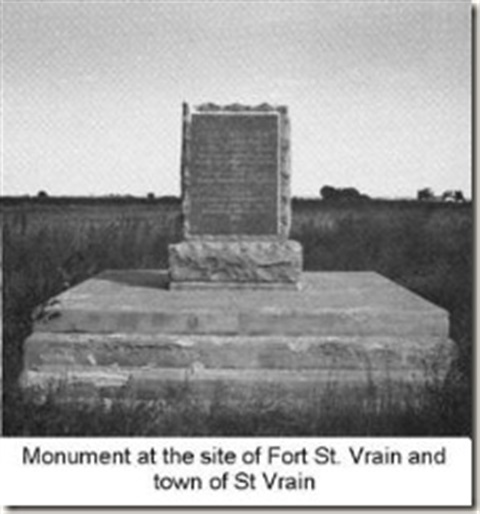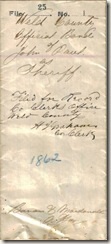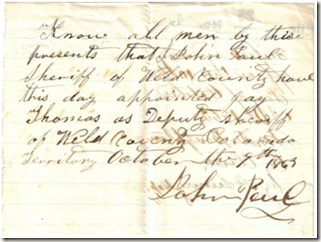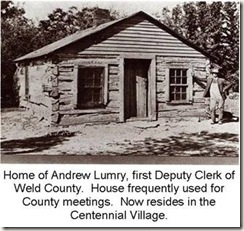Weld County's First Sheriff

On February 28, 1861, President James Buchanan signed An Act to provide a temporary Government for the Territory of Colorado, commonly known as the Colorado Organic Act, creating the Territory of Colorado. This act provided the US President authority to appoint a Territorial Governor and Secretary.
President Lincoln originally preferred General William Larimer for the post of Governor, but William Gilpin was appointed by the newly-elected President Lincoln twenty-five days later on March 25, 1861. This has been interpreted by historians as a concession to Missouri Governor Frank Blair in an attempt to appease political tensions approaching the Civil War.
For the post of Secretary, Lincoln appointed Lewis Ledyard Weld, a lawyer practicing in the Pike’s Peak area of what was then the unrecognized Jefferson Territory and officially part of the Territory of Kansas. Weld served the Territory well, credited with helping create the state seal and lending the Weld family motto as the official motto of Colorado, “Nil Sine Nomine”, interpreted from Latin as “Nothing Without (either “God”, “Providence”, or “the Deity”).
Weld County was formed on September 9, 1891, when the Territorial Assembly created the original seventeen counties. Its boundaries approximately coincided with the previous boundaries of St. Vrain County, Jefferson Territory. The county seat was placed at the town of St. Vrain, which was abandoned by the 1880s. The Territorial Assembly appointed the first, temporary County Commissioners and charged them with conducting the first Territorial Election on December 2, 1861. It was in this election that Weld County’s first Sheriff, John Paul, was elected.
According to US Census records, John Paul was born in Tennessee between approximately 1818 and 1820. His wife, Esther, was possibly born in Iowa at roughly the same time. Before arriving in the Colorado Territory, they had seven children (approx DOB), William (1842), Paul Jr. (1844), Theodore (1848), Elizabeth (1850), Rebecca (1852), Josiah (1855), and Ouella (1858). Records indicate that they were a mobile family, moving between Iowa, Indiana, Illinois, and Kansas. In 1860, the Paul family was living in the Washington Township of Anderson County, Kansas, coincidentally located just thirteen miles southwest of Greeley, Kansas. Between the summer of 1860 and the fall of 1861, the family moved to Colorado.


During that time in the Colorado Territory, pioneers were platting out the town of St. Vrain in and around the remains of the old trading post of Fort St. Vrain near the confluence of the St. Vrain and Platte rivers just north of modern day Platteville. According to land and tax records of the time, John Wheeler had claimed the area immediately around the actual old fort and had begun to build a house. By 1860, he had a foundation for a home built from ash, cottonwood, and other native trees just inside the gates of the old fort. Building the town of St. Vrain was slow going, as noted by Colorado pioneer W. D. Anthony who passed the ‘town’ in June of 1860 and wrote that it consisted of only three wooden framed houses. Wheeler himself was unhappy with the placement of his home and, according to land and tax documents, when the Paul family arrived from Kansas he gave over this foundation and acreage to the Pauls and claimed a different homestead some two and a half miles further downstream on the Platte. The Pauls were now settler-farmers in Colorado.
Being elected Sheriff, rather than being appointed, requires being held in some high esteem by your fellow citizens. Exactly how and when John Paul garnered this respect from his fellow setters is not documented, but by the first Territorial Election on December 2, 1861, he was regarded well enough that he was duly elected Sheriff. He appears to have served well as he was re-elected in a second election on October 7, 1862. Then, as the county was organizing and need for law enforcement grew, John Paul saw fit to deputize a citizen to fill the County’s need. On October 9, 1863, Sheriff Paul appointed Jay Thomas as the first recorded Deputy Sheriff.
 During the early history of Weld County, County buildings were rare, if not non-existent, so County business was often conducted wherever officers found themselves. According to the St. Vrain Book, where the County Clerk recorded the minutes, notes, and orders of the County Commissioners from 1859 to 1864, the Commissioners authorized County officers to “keep their offices” in their homes when the Commissioners where not in session. During sessions, the home of the County Clerk or Deputy Clerk would have been the official place of business. By this decree, the first Sheriff’s Office would have been John Paul’s home inside the grounds of the Old Fort St. Vrain.
During the early history of Weld County, County buildings were rare, if not non-existent, so County business was often conducted wherever officers found themselves. According to the St. Vrain Book, where the County Clerk recorded the minutes, notes, and orders of the County Commissioners from 1859 to 1864, the Commissioners authorized County officers to “keep their offices” in their homes when the Commissioners where not in session. During sessions, the home of the County Clerk or Deputy Clerk would have been the official place of business. By this decree, the first Sheriff’s Office would have been John Paul’s home inside the grounds of the Old Fort St. Vrain.
After serving for just under three years, Sheriff John Paul’s time in office was peacefully concluded on the 13th of September, 1864, with the election of Benjamin Ogle to the Office of Sheriff. The first Sheriff, and now private citizen, John Paul continued to work his two-hundred acres beside the St. Vrain River until late 1869. By 1870, his family had again moved on, away from St Vrain valley. It is reported that some members of the Paul family may have stayed in the area, as local reports seem to record a typically incongruous event for the old west.
According to local historians and published works, one of the earliest, possibly the very first, defendant in a criminal trial in Weld county, one Mr. Sam Ashcroft (possibly Ashcraft), had a son Henry. It is local history that Henry married either Elizabeth or Rebecca Paul. However records and therefore verification of that marriage have been difficult to obtain. On the other hand, the youngest daughter, Ouella, is recorded as marrying one Gideo Beardsley on July 29, 1873, at the age of sixteen and by 1880 they had a son, Carl (1873) and a daughter, Era (1876).
What is known of John is that by 1880, he, his wife Esther, his son Paul Jr, and Paul Jr.’s wife were recorded as prospectors and miners in Summit County. From there, the trail grows cold and the remaining chapters of the John Paul story, along with final resting place of one of Weld County’s settler sons, lies in yet undiscovered country.
Story by Paul Harvey, Weld County Sheriff’s Office Crime Analyst
Did You Know?
In 1860, the Paul family was living in the Washington Township of Anderson County, Kansas, coincidentally located just thirteen miles southwest of Greeley, Kansas.